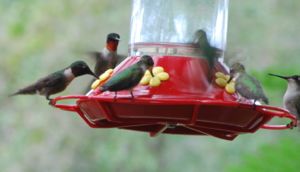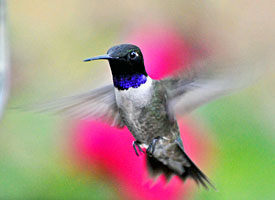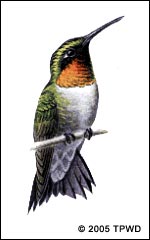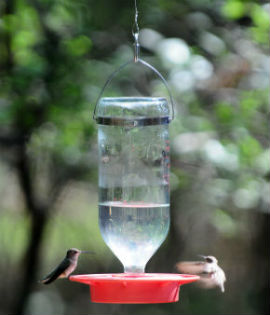Hummingbirds will be migrating through Texas throughout this month.
Sept. 11, 2013
 Hummingbirds are flying through North Texas right now and they could use some help.
Hummingbirds are flying through North Texas right now and they could use some help.
The jetsetters are traveling from as far north as Alaska on their way to their winter homes in southern Mexico and Central America.
They’ll be stopping in DFW to refuel in the coming weeks for the next leg of their trip. However, blooms are scarce in some parts of the Metroplex due to the drought.
(Above, courtesy Mark Klym. Below, TPWD.)
 “All wildlife is having a hard time with the drought,” said Mark Klym, coordinator for the Texas Hummingbird Roundup at the Texas Parks and Wildlife Department. “It’s a strain on them. The migration is always energy demanding and strenuous on an animal.”
“All wildlife is having a hard time with the drought,” said Mark Klym, coordinator for the Texas Hummingbird Roundup at the Texas Parks and Wildlife Department. “It’s a strain on them. The migration is always energy demanding and strenuous on an animal.”
According to Klym, it’s the beginning of the heavy migration period for hummingbirds in Texas, which runs from late August and peaks the second or third week in September, extending into October.
There are 16 species found in Texas but around DFW the ruby-throated, the rufous and the black-chinned are the most frequently seen passing through.
Klym said the marathon flyers prefer to fatten up on the nectar of native plants such as turk’s cap, salvia and trumpet vine. However these plants may not be flourishing enough to supply the calories they need to fly an average of 25 miles a day. Habitat destruction is also putting a strain on the species.
North Texans can help the jet-lagged visitors by putting up feeders in their yards to supplement the native plants they snack on.
 Insects are equally important to their diet. While 40 percent of a hummingbird’s diet is from the power drinks of nectar or sweet water, about 60 percent is made of insects, such as spiders, gnats and aphids. Klym worries that local spraying for mosquitos to ward off West Nile Virus could be harming their food supply. He urges homeowners to refrain from using pesticides.
Insects are equally important to their diet. While 40 percent of a hummingbird’s diet is from the power drinks of nectar or sweet water, about 60 percent is made of insects, such as spiders, gnats and aphids. Klym worries that local spraying for mosquitos to ward off West Nile Virus could be harming their food supply. He urges homeowners to refrain from using pesticides.
[Above, black-chinned hummingbird. Courtesy of Cornell Lab of Ornithology]
 “It’s very important that they have insects to eat,” he said.
“It’s very important that they have insects to eat,” he said.
A shallow water source is also vital.
Early in the season, hummingbirds may stick around 3 to 4 days but later in season they may just stop by overnight.
And while hummingbirds have been known to fly an impressive 60 miles an hour, nearly as fast as a cheetah, they still have predators. Small hawks, cardinals, preying mantis and even dragonflies have been known to ambush them.
“It’s a jungle out there,” Klym said.
[Above, ruby-throated hummingbird, courtesy of TPWD]
 TIPS FOR HUMMINGBIRD FEEDERS
TIPS FOR HUMMINGBIRD FEEDERS
• Buy a hummingbird feeder that’s easy to take apart to clean.
• Hummingbird food should contain 4 parts water to 1 part sugar.
• Use white sugar only.
• Don’t use red dye.
• Change out mixture every two days.
• Clean feeders at least every 6 days to keep them free of mold, which can harm hummingbirds.
• Hummingbirds are territorial, so separate the feeders.
Stay up to date on everything green in North Texas, including the latest news and events! Sign up for the weekly Green Source DFW Newsletter! Follow us on Facebook and Twitter. Also check out our new podcast The Texas Green Report, available on your favorite podcast app.









